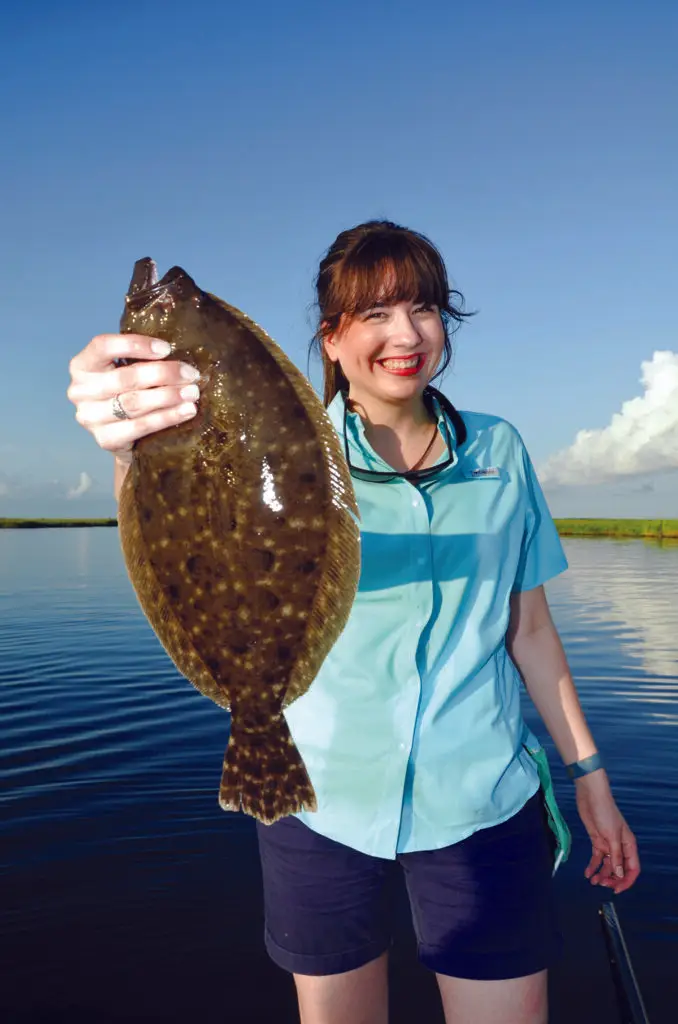Since about 2009, sportsmen in the southern Atlantic and Gulf Coast states have reported catching fewer flounder than normal. The Alabama southern flounder population reached its lowest point in 2017-19.
“All southeastern states where southern flounder naturally occur in the Atlantic Ocean or the Gulf of Mexico experienced a similar decline in their populations around 2009-10,” says Kevin Anson, chief of fisheries for the Alabama Marine Resources Division. “We think environmental changes affected flounder during that period. Beginning around 2009, winters became warmer and the cold period was not as pronounced as it had been in previous years. In addition, we had droughts.”
For many reptiles and some fishes, their sex can be determined by the temperatures in their surrounding environment. Researchers theorize that if water gets too warm too fast, most young flounder will become males. That reduces the reproductive potential of the population.
“Studies indicate a strong correlation in southern flounder between water temperatures and a sex change in young flounder if they are exposed to water temperatures colder or warmer than a narrow temperature band,” Anson explains. “If we had two or three years back-to-back that don’t support 50 percent being female, there will be fewer reproducing females in the water.”
In 2019, Alabama changed its regulations to allow more flounder to reproduce at least once. Each angler can keep five flounder per day, down from 10 previously. The minimum length increased from 12 to 14 inches and anglers cannot keep flounder during November.
Male southern flounder generally stay farther offshore and seldom grow longer than 14 inches. A female flounder takes about 12 to 18 months to reach legal size, about the same time she can start reproducing. Females stay in inshore waters more than the males. Therefore, fishing pressure almost entirely impacts the female population.

Hoping to increase flounder populations, Alabama biologists began spawning southern flounder at the Claude Peteet Mariculture Center in Gulf Shores in the last few years. Since 2019, the hatchery has released about 270,000 young flounder, each between one and two inches long.
“We collect wild fish each year and rotate the brood stock so we’re not always spawning the same males and females,” says Max Westendorf, the Claude Peteet facility manager. “We want to release a more genetically diverse population. In the hatchery, it takes southern flounder about 50 days to reach an inch long. Hatchery fish have a better chance of survival because they are a little farther along in their development than wild fish when we release them.”
Researchers collect wild brood stock from anglers. Most specimens come from flounder caught during fishing tournaments.
“We partner with Saltwater Finaddicts,” Westendorf says. “They hold a fishing tournament every summer and created a live flounder category with prizes to incentivize anglers to bring in live flounders. They’ll give us between 35 to 135 flounder each year for us to use as brood stock.”
The good news is that the regulation change and the release of hatchery-raised fish seems to be working. In the past few years, many Alabama anglers reported catching more flounder.
“This year seems to be a much better year, but we don’t have enough information to determine if it’s back to what it was before 2009,” Anson says. “We like to think there is a positive benefit with increasing the size limit.”
People can’t tell the difference between a wild fish and one raised in a hatchery by looking at them. Some fish, though, do stand out!
“About 40 to 50 percent of the flounder we raise have a nutrient deficiency that results in them being malpigmented,” Westendorf says. “Not just southern flounder, but it occurs in all flatfish. Juvenile flounder are almost translucent in the hatchery. As they grow, some turn into albinos.”
Malpigmented adults might look mostly white or white mixed with their normal brown coloration. Their lack of mottled camouflage can affect how these ambush predators hunt. Typically, flounder bury themselves in the mud waiting for prey to pass close to them. Without that coloration, few albino fish likely survive into adulthood. Researchers do not know if these oddly-colored fish will revert to their usual coloration in the wild after eating all the natural foods that flounder like.
“We believe it’s a nutritional problem, not a genetic problem,” Westendorf says. “In Alabama, we never had anyone report catching an albino flounder. If someone caught an albino flounder, it was most likely a hatchery fish. In the wild, less than one percent of flounder have malpigmentation.”ν
For more information on Saltwater Finaddicts, see saltwaterfinaddicts.com or look them up on Facebook.




